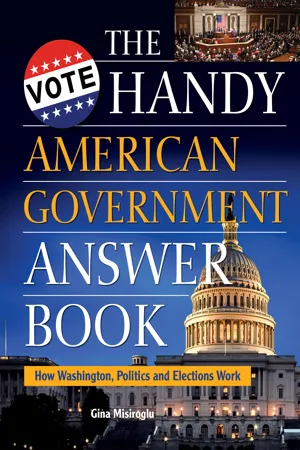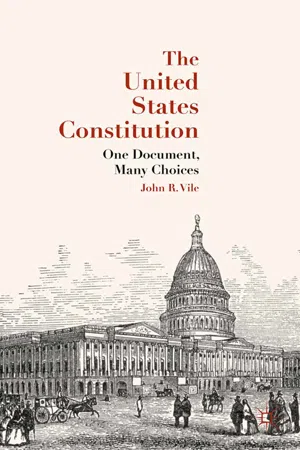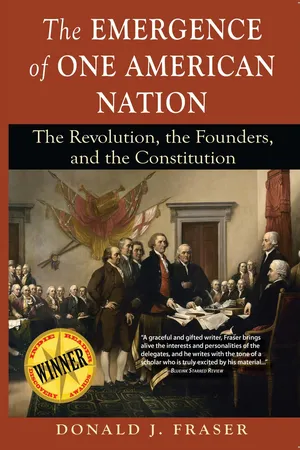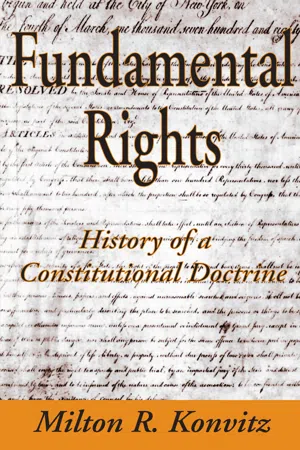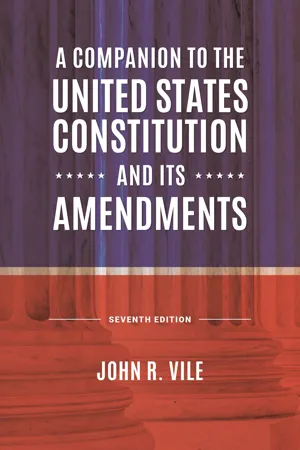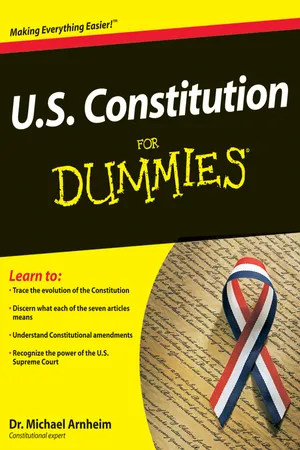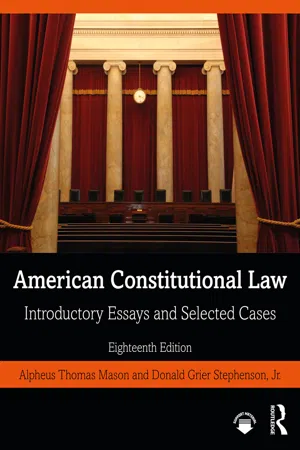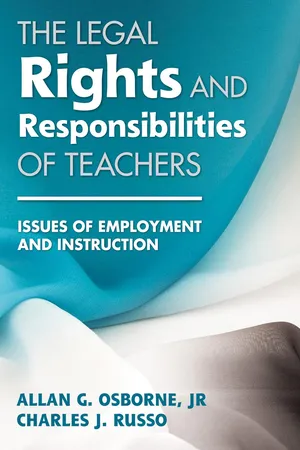Law
US Bill of Rights
The US Bill of Rights is the first ten amendments to the United States Constitution, which outline specific protections for individual liberties and rights. These amendments include guarantees such as freedom of speech, religion, and the press, as well as the right to bear arms, protection against unreasonable searches and seizures, and the right to a fair trial.
Written by Perlego with AI-assistance
Related key terms
Related key terms
1 of 4
Related key terms
1 of 3
12 Key excerpts on "US Bill of Rights"
- eBook - ePub
The Handy American Government Answer Book
How Washington, Politics and Elections Work
- Gina Misiroglu(Author)
- 2017(Publication Date)
- Visible Ink Press(Publisher)
Because the American Revolution was fought to preserve and expand the rights of the individual against the government, America’s Founding Fathers boldly proclaimed these rights in the opening of the Declaration of Independence: “We hold these truths to be self-evident, that all men are created equal, that they are endowed by their Creator with certain unalienable Rights, that among these are Life, Liberty, and the pursuit of Happiness.” In this document, the authors expressed their belief in certain inalienable, Godgiven rights that all people are inherently created with and entitled to enjoy simply because they are human beings, including the rights to life, liberty, and the pursuit of happiness. These rights are not destroyed when civil society is created, and neither society nor government can remove or “alienate” them. Most democratic societies agree that inalienable rights include freedom of speech and expression, freedom of religion and conscience, freedom of assembly, and the right to equal protection before the law. Since these rights exist independently of government, they cannot be taken away by legislation nor are they subject to the whim of an electoral majority.THE BILL OF RIGHTS What is the Bill of Rights?The Bill of Rights—collectively, the first ten amendments to the U.S. Constitution— guarantees rights and liberties to the American people. These amendments were proposed by Congress on September 25, 1789, and ratified as a block by three-fourths (eleven) of the states on December 15, 1791, thereby officially becoming part of the Constitution. The first eight amendments outline substantive and procedural individual rights guaranteed to all people, while the Ninth and Tenth Amendments are general rules of interpretation of the relations among the people, the state governments, and the federal government. Although the Bill of Rights was originally written to restrict the national government, the Supreme Court has nationalized the Bill of Rights by upholding that most of the provisions also apply to the states, as outlined by the Fourteenth Amendment’s Due Process Clause.How does the Bill of Rights protect individual liberties?The Bill of Rights limits the ability of government to intrude upon certain individual liberties, guaranteeing freedom of speech, press, assembly, and religion to all people. Nearly two-thirds of the Bill of Rights was written to safeguard the rights of those suspected or accused of crimes, providing for due process of law, fair trials, freedom from self-incrimination and from cruel and unusual punishment, and protection against double jeopardy: being tried more than once for the same crime. In short, the Bill of Rights places certain liberties beyond the reach of those in power on the premise that depriving citizens of fundamental rights diminishes their civil standing and ultimately their humanity. Since the adoption of the Bill of Rights, only seventeen additional amendments have been added to the Constitution. While a number of these amendments revised how the federal government is structured and operates, many followed precedent established by the Bill of Rights and expanded individual rights and freedoms. - eBook - ePub
The United States Constitution
One Document, Many Choices
- J. Vile(Author)
- 2015(Publication Date)
- Palgrave Macmillan(Publisher)
Chapter Seven The Bill of Rights and Freedom of Belief and Expression: They Provide for Liberty, Not LicenseThe first Congress proposed 12 amendments in 1789, and the necessary number of states ratified ten of them in 1791. Modern scholars typically refer to these amendments collectively as the Bill of Rights. The early adoption of these amendments seemed to confirm Federalist arguments that the amending process would serve to remedy perceived defects in the document although it is more difficult to identify cases in early US history, where the government acted differently than had such rights not been so incorporated into the Document. By contrast, the Bill of Rights has been the basis of numerous judicial decisions in the twentieth and twenty-first centuries.What Was the Impetus for the Bill of Rights?In retrospect, it might seem odd that the US Constitution did not initially include a Bill of Rights. Virginia had adopted a Declaration of Rights in 1776 that had been highly influential in convincing most states to adopt similar declarations or bills limiting the powers of the government. By contrast to the language that would be incorporated into the national bill of rights, many of the state bills were aspirational statements as to what governments should or ought to do rather than imposing specific restraints on governmental behaviors that individuals would necessary invoke in court.Most American Framers were deeply committed to the idea of liberty under law, and there is merit in the observation made by Alexander Hamilton in Federalist no. 84 “that the Constitution is itself, in every rational sense, and to every useful purpose, A BILL OF RIGHTS” (1961, 515). It served as such a protection by allocating, dividing, and balancing powers to prevent governments from trespassing on individual rights. As discussed chapter two - eBook - ePub
The Emergence of One American Nation
The Revolution, the Founders, and the Constitution
- Donald J Fraser(Author)
- 0(Publication Date)
- Fraser & Associates(Publisher)
HAPTER 12The Bill of Rights / July 1789 to December 1791
“Congress shall make no law…”– FIRST AMENDMENT –N ational Public Radio personality Peter Sagal produced a PBS series on the Constitution in 2013. In the second installment, he said, “Ask anybody on the street about the meaning of the Constitution and they will give you a one word answer: freedom.” But the Constitution does not mention the word freedom anywhere. The first ten amendments, known as the Bill of Rights, rectified this problem. For many Americans, the protections contained in the Bill of Rights, including freedom of speech, religion, and press; the right to bear arms; the provision for jury trials; and other protections of civil liberties, are the very heart of the American Constitution.Madison Changes His Mind on a Bill of Rights
James Madison had gradually changed his mind. Originally opposed to adding an enumeration of rights to the Constitution, Madison remained silent when George Mason proposed one at the end of the Federal Convention. During the Virginia ratification process, he had acquiesced to the need for amendments, but only after the Constitution was approved. At that point, he was still personally opposed to such amendments, largely because he believed they would be ineffective in protecting rights. But in June of 1789, Madison proposed a series of amendments to the Constitution in the first Congress, most of which dealt with rights.Madison’s evolving views on the subject resulted from several factors. Jefferson’s insistence on the need for a bill of rights played a part, as did practical politics. To get elected to the House of Representatives, Madison promised his constituents he would support a bill of rights. Another part of his support was based on his view of the dangers of a second Constitutional Convention, which he hoped to forestall by offering amendments to the Constitution. He knew the Antifederalists would use a second convention not just to add an enumeration of rights, but to weaken the federal government. Most importantly, Madison became a fervent supporter of adding a bill of rights because he saw it as a way to create national unity. The struggle for ratification had been divisive, and he knew that the union would not long endure if half of the people opposed it. - eBook - ePub
Fundamental Rights
History of a Constitutional Doctrine
- Milton Konvitz(Author)
- 2017(Publication Date)
- Routledge(Publisher)
3 The Bill of Rights: A Bill of Fundamental RightsI.
We have seen that, despite rebuffs, Justices of the Supreme Court, time and again in strong dissenting opinions, affirmed their belief that fundamental rights are privileges and immunities guaranteed by the Constitution against denial or abridgment by the States. What are these fundamental rights? Perhaps the fullest and broadest enumeration of such rights was formulated by Justice Bradley in Slaughter-House. 1 His dissenting opinion is historically notable, however, for another reason, for we find in it, for the first time, the contention that Section 1 of the Fourteenth Amendment somehow “incorporates” the first eight amendments of the Constitution, that the rights enumerated in the Bill of Rights areamong the privileges and immunities of citizens of the United States, or what is still stronger for the force of the argument, the rights of all persons whether citizens or not.Since Justice Bradley made this contention in 1873, it has had an erratic career in constitutional jurisprudence, and has been disputed and refined, but the essence of Justice Bradley’s idea has won out and has become firmly fixed as constitutional doctrine. We can trace here only the main lines of this highly significant aspect of the idea of fundamental rights.Three years later, in 1876, the Court decided, what was perhaps the first case in which the claim was explicitly made, that one of the provisions of the Bill of Rights formulated a privilege or an immunity which a State may not infringe. In Walker v. Sauvinet, 2 - eBook - ePub
- Michael Arnheim(Author)
- 2018(Publication Date)
- For Dummies(Publisher)
Part 4Guaranteeing Important Rights: The Bill of Rights
IN THIS PART … Gain knowledge about your constitutional rights. Speak up! Find out about your right to freedom of speech as well as religion and assembly. Find out about the right to bear arms and prohibiting unreasonable search and seizure. Uncover what “Pleading the Fifth” is really all about. Understand your right to a fair trial and a trial by jury plus the regulation of cruel and unusual punishment. Note the Ninth Amendment — a guide on how to interpret the Constitution — and tackle the Tenth Amendment — described by Thomas Jefferson as “the foundation of the Constitution.”Passage contains an image
Chapter 14The First Amendment: Freedom of Religion, Speech, and Assembly
IN THIS CHAPTERExamining the text of the First AmendmentEstablishing freedom of religionSafeguarding freedom of speech responsiblyProtecting national secretsAssuring freedom of assembly and associationThe First Amendment forms part of the Bill of Rights — the name we give to the first ten amendments. The First Amendment is arguably the most important part not only of the Bill of Rights but also of the Constitution as a whole because it guarantees some pretty fundamental rights:- Freedom of religion and belief
- Freedom of speech
- Freedom of the press
- Freedom of assembly and association
- Freedom to petition the government
Considering the Amendment’s Wording
Here’s what the First Amendment says:Congress shall make no law respecting an establishment of religion, or prohibiting the free exercise thereof; or abridging the freedom of speech, or of the press; or the right of the people peaceably to assemble, and to petition the Government for aredress of grievances.Prohibiting Congress from taking away rights
Notice the unusual wording. The whole amendment is governed by the opening phrase “Congress shall make no law …” No other amendment starts that way. How come the First Amendment differs from all the other amendments in this important respect? - John R. Vile(Author)
- 2021(Publication Date)
- Praeger(Publisher)
HAPTER 7THE BILL OF RIGHTS —THE FIRST AMENDMENTThe first ten amendments to the Constitution are commonly designated as the Bill of Rights. Congress proposed these amendments in 1789, and the required number of states ratified them in 1791. In addition to protecting civil liberties and the rights of the states, these amendments provide further insight into the values of those who wrote the Constitution and the controversies surrounding its ratification.BACKGROUNDDebates over the proposed Constitution split the nation into two camps. Federalists supported the new Constitution, and Anti-Federalists opposed it. Anti-Federalists feared that the new national government was too strong—so strong that it would abuse personal rights. Federalists argued that the structure of the new national government would restrain it from acting oppressively, and that it could only exercise the powers the Constitution delegated to it. Despite such assurances, Anti-Federalists continued to insist on binding the new national government, as they had bound their own state governments, by additional written restraints. As he argued in letters to his friend James Madison, Thomas Jefferson argued that a bill of rights might help secure liberties after the Constitution (which he supported) went into effect.Eventually, prominent Federalists agreed to support a bill of rights if the states ratified the Constitution. James Madison, who represented a Virginia district in the U.S. House of Representatives, took the lead in shaping the Bill of Rights and getting it through the first Congress. Madison saw adoption of the Bill of Rights as a way of avoiding a second constitutional convention. He sought to guarantee individual rights without diluting the strength of the new national government through amendments that would alter the structure of the new government. Although some Anti-Federalists were clearly committed to civil liberties, others used fears that the government would abuse individual rights as a smokescreen to oppose a more powerful national government.- eBook - ePub
- Michael Arnheim(Author)
- 2009(Publication Date)
- For Dummies(Publisher)
Part IV The Bill of Rights: Specifying Rights through AmendmentsIn this part . . .Here’s where you get the lowdown on your constitutional rights. The Bill of Rights may have been an afterthought as far as the Framers of the Constitution were concerned, but for most people these first ten amendments are crucial. Read all about them here.Passage contains an image
Chapter 14 The First Amendment: Freedom of Religion, Speech, and Assembly In This Chapter Establishing freedom of religion Protecting freedom of speech responsibly Guarding against obscenity Protecting freedom of assembly and associationThe First Amendment forms part of the Bill of Rights — the name we give to the first ten amendments. The First Amendment is arguably the most important part not only of the Bill of Rights but also of the Constitution as a whole because it guarantees some pretty fundamental rights:Freedom of religion and belief Freedom of speech Freedom of the press Freedom of assembly and association Freedom to petition the government In this chapter, I explain each of these rights and how they’ve been interpreted through the years. Considering the Amendment’s Wording Here’s what the First Amendment says:Congress shall make no law respecting an establishment of religion, or prohibiting the free exercise thereof; or abridging the freedom of speech, or of the press; or the right of the people peaceably to assemble, and to petition the Government for a redress of grievances.Prohibiting Congress from taking away rightsNotice the unusual wording. The whole amendment is governed by the opening phrase “Congress shall make no law . . .” No other amendment starts that way. How come the First Amendment differs from all the other amendments in this important respect?The answer is that in this amendment the Framers were not granting new rights to the people. They assumed that those rights already existed. The amendment was clearly designed to stop Congress from taking away rights that already existed. - eBook - ePub
- Patrick M. Garry(Author)
- 2012(Publication Date)
- University of Missouri(Publisher)
It supplemented the enumerated powers limitation by further requiring that even if the national government were engaged in an activity authorized by Articles I, II or III of the Constitution, it could only do so within the boundaries set up by the Bill of Rights. What is typically forgotten (or deliberately obscured) in the popular telling of the story of the Bill of Rights is that the states retained the power to do precisely those things (establishing a state religion, punishing unpopular speech, denying the right to trial by jury, etc.) that were forbidden to the national government. 41 Under this limited-government model, the rights set out in the Bill of Rights were those seen to be particularly necessary to limit the power of government and preserve the people’s right to control the power of government and keep it in a limited position. This point was made by Hardin Burnley in a letter to James Madison: “By protecting the rights of the people and of the states, an improper extension of power will be prevented and safety made equally certain.” 42 The debates over the Bill of Rights reveal that there was very little disagreement over the listing of freedoms guaranteed in the first eight amendments. 43 The framers and ratifiers did not engage in extensive discussion about the nature or parameters of the rights mentioned in the Bill of Rights. For instance, with the First Amendment, there was no discussion about the role of a free press in a democracy or whether certain measures to control, regulate, or protect the press would be enforceable, or what the limits are of free speech, or what the definition of speech actually is, or whether certain harmful speech would be protected by the First Amendment - eBook - ePub
No Law
Intellectual Property in the Image of an Absolute First Amendment
- David L. Lange, H. Jefferson Powell(Authors)
- 2008(Publication Date)
- Stanford Law Books(Publisher)
The [first ten] amendments were offered to curtail and restrict the general powers granted to the Executive, Legislative, and Judicial Branches two years before in the original Constitution. The Bill of Rights changed the original Constitution into a new charter under which no branch of government could abridge the people’s freedoms of press, speech, religion, and assembly. Yet the Solicitor General argues and some members of the Court appear to agree that the general powers of the Government adopted in the original Constitution should be interpreted to limit and restrict the specific and emphatic guarantees of the Bill of Rights adopted later. I can imagine no greater perversion of history. Madison and the other Framers of the First Amendment, able men that they were, wrote in language they earnestly believed could never be misunderstood: “Congress shall make no law. . . abridging the freedom. . . of the press. . . .” Both the history and language of the First Amendment support the view that the press must be left free to publish news, whatever the source, without censorship, injunctions, or prior restraints. 53 Solicitor General Griswold’s argument, in other words, turned the original history of the First Amendment upside down: instead of treating the amendment, as its language and its origins require, as a restraint on the powers granted by the original text of the Constitution, Griswold wanted the Court to use the powers granted in 1787–88 to adjust, by judicial fiat but in what the executive deemed a socially valuable fashion, the denial of power adopted in 1789–91 - eBook - ePub
The Constitution of South Africa
A Contextual Analysis
- Heinz Klug(Author)
- 2010(Publication Date)
- Hart Publishing(Publisher)
To this end, the Bill of Rights addresses some of the most egregious consequences of the legally imposed inequalities of the past—such as access to land ownership. It also adopts a broad definition of equality that includes provisions that protect affirmative action as a mechanism to deal with this legacy. In addition to prohibiting discrimination on the basis of race, sex, age and ethnic origin, the Bill of Rights also lists the following categories of protection: pregnancy, marital status, sexual orientation, disability and language. Furthermore, in cases of alleged discrimination on any of the listed grounds, such discrimination is assumed to be unfair, thus shifting the burden of proof onto those denying that the prima facie effect of discrimination is not the consequence of their actions. Finally, these constitutional protections are not limited to relations between the state and individuals; they are applied to both governmental and private conduct, with the Constitution mandating the legislature to enact laws to prevent or prohibit unfair private discrimination. The Promotion of Equality and Prevention of Unfair Discrimination Act enacted in February 2000 to fulfil this constitutional mandate is a wide-ranging statute that aims to eradicate social and economic inequalities, ‘especially those that are systematic in nature, which are generated in our history by colonialism, apartheid and patriarchy, and which brought pain and suffering to the great majority of our people’. 8 The state is explicitly charged with the duty to ‘respect, protect, promote, and fulfil the rights in the Bill of Rights’. 9 Yet it is important to recognise that the rights guaranteed are subject to limitations, which the Bill of Rights explicitly provides. While it is commonly understood that no rights are absolute—and that one person’s rights might indeed interfere with the exercise of another person’s—the Constitution does not simply leave the policing of these boundaries to the courts - eBook - ePub
American Constitutional Law
Introductory Essays and Selected Cases
- Donald Grier Stephenson Jr., Alpheus Thomas Mason(Authors)
- 2021(Publication Date)
- Routledge(Publisher)
First the omission of a bill of rights providing clearly and without the aid of sophisms for freedom of religion, freedom of the press, protection against standing armies, restriction against monopolies, the eternal and unremitting force of the habeas corpus laws, and trials by jury in all matters of fact triable by the laws of the land and not by the law of Nations. To say, as Mr. [James] Wilson does, that a bill of rights was not necessary because all is reserved in the case of the general government which is not given, while in the particular ones all is given which is not reserved might do for the Audience to whom it was addressed, but is surely gratis dictum [a mere assertion], opposed by strong inferences from the body of the instrument, as well as from the omission of the clause of our present confederation which had declared that in express terms. It was a hard conclusion to say because there has been no uniformity among the states as to the cases triable by jury, because some have been so incautious as to abandon this mode of trial, therefore the more prudent states shall be reduced to the same level of calamity. It would have been much more just and wise to have concluded the other way that as most of the states had judiciously preserved this palladium, those who had wandered should be brought back to it, and to have established general right instead of general wrong. Let me add that a bill of rights is what the people are entitled to against every government on earth, general or particular, and what no just government should refuse, or rest on inference…. JAMES MADISON TO THOMAS JEFFERSON, 17 OCTOBER 1788 Experience proves the inefficacy of a bill of rights on those occasions when its control is most needed. Repeated violations of these parchment barriers have been committed by overbearing majorities in every State…. Wherever the real power in a Government lies, there is the danger of oppression - eBook - ePub
The Legal Rights and Responsibilities of Teachers
Issues of Employment and Instruction
- Allan G. Osborne, Charles Russo(Authors)
- 2011(Publication Date)
- Corwin(Publisher)
3BasicConstitutionalRights andFreedoms
KEY CONCEPTS IN THIS CHAPTER- Free Speech Rights
- Rights of Association
- Freedom of Religion
- Privacy Rights
- Due Process
INTRODUCTION
The U.S. Constitution outlines the basic rights of all Americans. Teachers enjoy their constitutional rights even when they are within the walls of public school buildings.1 Even so, school officials may curtail the constitutional rights of teachers when there is a legitimate governmental interest in doing so. Although school boards cannot insist that teachers surrender their basic rights as a prerequisite for employment, since teachers are in sensitive positions, some limitations may be placed on their full exercise of those rights, particularly in the classrooms where, for example, they may not endorse political candidates or profess their religious beliefs.This chapter is not intended to be a comprehensive review of teachers’ rights. Rather, this chapter provides a brief introduction to and overview of the constitutional principles underlying the legal controversies in the issues presented in much greater detail in later chapters. Specifically, the chapter deals with the rights of free speech and association, freedom of religion, privacy, and aspects of due process. Insofar as each of these topics is discussed in greater detail later in the book, the intent of this chapter is to establish the constitutional foundation, with a few examples taken from case law, for many of the rights and freedoms to which teachers are entitled. A second purpose of the chapter is to provide a brief introduction to some of the more contentious issues that have been litigated. Because many of the basic rights of teachers were established through court decisions from other areas of public employment, some of the cases discussed in this chapter do not involve teachers; they are cited because the legal principles that they enunciated are applicable to educators.
Index pages curate the most relevant extracts from our library of academic textbooks. They’ve been created using an in-house natural language model (NLM), each adding context and meaning to key research topics.
Explore more topic indexes
Explore more topic indexes
1 of 6
Explore more topic indexes
1 of 4
